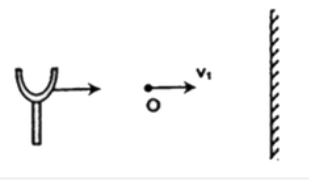A person carrying a whistle emitting continuously a note of 272Hz is runnig towards a reflecting surface with a speed of 18km/h. The speed of sound in air is 345ms−1 The number of beats heard by him is
4
6
8
0
The correct Answer is:C
To solve the problem, we need to find the number of beats heard by a person carrying a whistle emitting a frequency of 272 Hz while running towards a reflecting surface. The speed of sound in air is given as 345 m/s, and the person is running at a speed of 18 km/h.
1. Convert the speed of the person from km/h to m/s:
Speed in m/s=Speed in km/h×518
Speed=18×518=5 m/s
2. Calculate the frequency of the sound heard by the wall (f'):
Using the Doppler effect formula for the frequency observed by a stationary observer (the wall):
f′=f(v+vov−vs)
Here, f=272 Hz, v=345 m/s, vo=0 (the wall is stationary), and vs=5 m/s (the person is moving towards the wall).
f′=272(345+0345−5)=272(345340)
3. Calculate f':
f′=272×1.0147≈276.0 Hz
4. Calculate the frequency of the echo heard by the person (f2):
Now, the wall acts as a source of sound, and the person is the observer moving towards the wall. The frequency heard by the person (f2) is given by:
f2=f′(v+vov−vs)
Here, vo=5 m/s (the person is moving towards the wall), and vs=0 (the wall is stationary).
f2=f′(345+5345−0)=f′(350345)
Substituting f′≈276.0 Hz:
f2=276.0(350345)≈276.0×1.0145≈280.0 Hz
5. Calculate the beat frequency (f_beat):
The beat frequency is given by the absolute difference between the two frequencies:
fbeat=|f1−f2|
Where f1=272 Hz (the frequency of the whistle).
fbeat=|272−280|=8 Hz
Final Answer:
The number of beats heard by the person is 8 Hz.
Speed in m/s=Speed in km/h×518
Speed=18×518=5 m/s
Using the Doppler effect formula for the frequency observed by a stationary observer (the wall):
f′=f(v+vov−vs)
Here, f=272 Hz, v=345 m/s, vo=0 (the wall is stationary), and vs=5 m/s (the person is moving towards the wall).
f′=272(345+0345−5)=272(345340)
f′=272×1.0147≈276.0 Hz
Now, the wall acts as a source of sound, and the person is the observer moving towards the wall. The frequency heard by the person (f2) is given by:
f2=f′(v+vov−vs)
Here, vo=5 m/s (the person is moving towards the wall), and vs=0 (the wall is stationary).
f2=f′(345+5345−0)=f′(350345)
Substituting f′≈276.0 Hz:
f2=276.0(350345)≈276.0×1.0145≈280.0 Hz
The beat frequency is given by the absolute difference between the two frequencies:
fbeat=|f1−f2|
Where f1=272 Hz (the frequency of the whistle).
fbeat=|272−280|=8 Hz
The number of beats heard by the person is 8 Hz.
Topper's Solved these Questions
- WAVESBOOK - AAKASH INSTITUTE ENGLISHCHAPTER - WAVESEXERCISE - Assignment (Section-C)
11 Videos
- WAVESBOOK - AAKASH INSTITUTE ENGLISHCHAPTER - WAVESEXERCISE - Assignment (Section-D)
9 Videos
- WAVESBOOK - AAKASH INSTITUTE ENGLISHCHAPTER - WAVESEXERCISE - Assignment (Section-A)
55 Videos
- WAVE OPTICSBOOK - AAKASH INSTITUTE ENGLISHCHAPTER - WAVE OPTICSEXERCISE - Assignment (Section-J (Aakash Challengers question))
1 Video
- WORK, ENERGY AND POWERBOOK - AAKASH INSTITUTE ENGLISHCHAPTER - WORK, ENERGY AND POWEREXERCISE - Assignment (SECTION - D)
13 Videos
Similar Questions
A person with vibrating tuning fork of frequency 338 Hz is moving towards a vertical wall with speed of 2ms−1 Velocity of sound in air is 340ms−1 The number of beats heard per second is
View SolutionA bus is moving with a velocity of 5ms−1 towards a huge wall. The driver sound a horn of frequency 165 Hz. If the speed of sound in air is 335ms−1, the number of beats heard per second by a passenger inside the bus will be
View SolutionThere is a source of sound (a tuning fork) moving towards a reflecting wall will a speed of 30ms−1. The velocity of the sound in air is 330ms−1and the frequency of the tuning fork is 600 Hz. The observer is between the source and the wall and is moving with some velocity V1 towards the wall. The beat frequency heard by the observer is 4 Hz. If the tuning fork is waxed, the frequency beats heard by the observer becomes 3 Hz. If the new frequency of tuning fork is k then k/50 is

View Solutiona bus is moving with a velocity 4 m/s towards a wall, the driver sounds a horn of frequency 173 Hz . if the speed of sound in air is 350 m/s. the number of beat heard per second by a passanger on the bus will be
View SolutionTwo factories are sounding their sirens at 800 Hz. A man goes from one factory to the other at a speed of 2 m/s. The velocity of sound is 320 m/s. The number of beats heard by the person is 1 s will be
View SolutionA car is moving with 90kmh−1 blows a horn of 150 Hz, towards a cliff. The frequency of the reflected sound heard by the driver will be (speed of sound in air is 340ms−1 )
View SolutionCalculate the beat frequency heard when two sound sources of wavelength 35cm and 35.2 cm are sounded together. The speed of sound in air is 330 ms−1
View SolutionWhat should be minimum length of an open organ pipe for producing a note of 110 Hz. The speed of sound is 330ms−1.
View SolutionA locomotive approaching a crossing at a speed of 20 ms−1 sounds a whistle of frequency 640 Hz when 1 km from the crossing. There is no wind and the speed of sound in air is 330 ms−1. What frequency is heard by an observer √3 km on the straight road from the crossing at right angle :-
View SolutionA whistle producing sound waves of frequencies 9500Hz and above is approaching a stationary person with speed vms−1. The velocity of sound in air is 300ms−1. If the person can hear frequencies upto a maximum of 10,000Hz.The maximum value of v upto which he can hear whistle is
View Solution